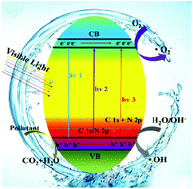C,N co-doped porous TiO2 hollow sphere visible light photocatalysts for efficient removal of highly toxic phenolic pollutants†
Abstract
Herein, C,N co-doped porous TiO2 hollow sphere visible light photocatalysts were fabricated using biocompatible N-lauroyl-L-glutamic acid as a doped precursor and soft-template by a mild and facile self-assembly soft-template method, followed by calcination at 550 °C in air. The structure, morphology, and surface elemental composition were characterized in detail by X-ray diffraction, Fourier transform infrared spectroscopy, X-ray photoelectron spectroscopy, scanning electron microscopy, and transmission electron microscopy. The results show that the prepared TiO2 photocatalysts have a porous hollow sphere structure and are co-doped with C and N. The visible-light-driven photocatalytic degradation rates of phenol and 2-chlorophenol are ∼92 and 90%, respectively. The photocatalytic reaction rate constants of phenol and dichlorophen on HPT550 porous TiO2 hollow spheres were about ∼4 and ∼2 times higher than those on P25, respectively. This enhancement is because the C,N co-doped porous TiO2 hollow spheres not only extend the photoresponse to the visible light region as C,N co-doping narrows the bandgap (2.7 eV), but also expose a large number of surface active sites that favor visible-light-driven photocatalysis. Moreover, the porous hollow structure favors multiple reflections of photons in the interior, increasing the utilization ratio of light. It is worth to pay more efforts to the development of visible light photocatalysts and further promote their practical application.



 Please wait while we load your content...
Please wait while we load your content...